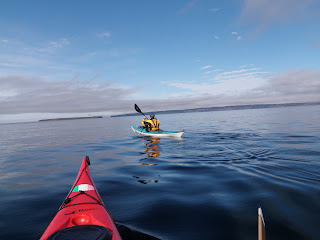For the past year or so I've been using a a Lexan water bottle hooked under the netting on the foredeck of my kayak. As of late, I've noticed my paddle hitting the bottle on every second stroke or so. I decided to pursue other options for water supply while paddling!! I thought about carrying a hydration bladder on my front deck but then looked into some under deck options. After seeing Gnaryldog's system I decided to embark upon my own!
I decided that I only needed a bladder and not a complete hydration pack which would include protective pack and carrying straps. I went with the Platypus Big Zip SL. It was available at the Outfitters, local shop, for 23.00 and while only 1.8l, it was well within the capacity that I wanted!! This unit has a quick disconnect hose - see observations below.
After buying the bladder, the next challenge was figuring out how to attach it to the under deck of the boat. I've seen others who have used anchors held in place by adhesives such as epoxy but I'm not into that kind of commitment. As in many of my projects, I decided to go with 3" suction cups!! No fuss, no muss, as I like to say. If they don't work, then just yank them out of there!!
 |
| Bladder and cups!! |
I never throw anything way so naturally I had an old folding chair in the attic. It turned out to be a great "hammock" for my bladder (ewwwwww)
 |
Just checking to see if a chair can become a hammock!!
|
After dry testing the "hammock" in my boat, I discovered that, due the shape of my cockpit coaming, I'd need to, somehow, increase the size of the hammock opening to allow easy loading/unloading of the bladder. It was either release a suction cup or some other option.
I did not like the idea of releasing/re-attaching a cup, so, after much head scratching, I opted to put a zipper in the hammock. I actually picked up the zipper at Walmart. I toyed with the idea of stitching in the zipper but decided to go with Aquaseal. I knew from previous projects that Aquaseal was more than enough for this application.
 |
| "Aquasealing" the zipper |
I added plastic reinforcements to the corners!
 |
| Zipper and reinforcements in place |
This is the first time I've used the Cotol accelerator with the Aquaseal. It cuts the cure time down DRAMATICALLY!!! Two hours from initial tack to dry testing is much better than 18 hrs!!
I did not like the idea of simply running a hose through my deck. I opted to run the hose through a custom grommet that I made from a rubber stopper - compliments of a local brew shop! I cut/sanded a groove in the stopper to allow easier placement in the deck, yet was watertight!!
 |
| Gettin' in the groove! |
 |
| Not painted but good to go! |
Not wanting to go willy nilly and cut a hole in my deck I decided to have a test run on a piece of test plastic!!
 |
| Through "deck" |
 |
| Above "deck" |
 |
| Below "deck" - quick disconnect fitting |
The test run on the Rubbermaid cover was a success!!
Below deck images are very hard to get (for me anyway) but here's what it all looks like. That orange thing to the left is my pump - it still fits under there!!! I should point out that the fore deck of my boat is VERY low. The height of the front coaming is only 12"! The fact that this unit actually fits in this small space is testimony to its compact nature!!
Drilling a hole in a perfectly good boat is still a bit unsettling. A good dose of "liquid courage", i.e. beer, does not hurt!!
 |
| We're goin' in!! |
I initially drilled with a 1/2 bit and then reamed out the hole with a round file as well as a steel rod wrapped in sand paper. It was controlled and relatively painless - phew!!
 |
| After clean up but not yet painted black! |
The result is a nice clean deck!!
Some observations:
The entire hose system can be removed from the boat. The quick disconnect on the bladder plus the rubber stopper on the deck allows the whole system to come out in one go. Pull the bladder and release the hose and the ENTIRE hydration system comes out of the boat!!
The zipper is a robust PLASTIC unit to resist corrosion.
The under deck housing of the hand pump is not affected.
This system is using space that is basically deemed "unusable"
While a PFD-mounted system could have been used a) this was cheaper, b) I find a PFD enough to carry on my back wihtout having a a few pounds of water and c)theoretically this puts the water at a lower C of G!!












































